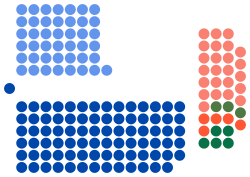House of Commons of Manitoba
| House of Commons of Manitoba Chambre des communes du Manitoba (fr) | |
|---|---|
| XXth Parliament | |
 | |
| Type | |
| Type | |
| Leadership | |
| Structure | |
| Seats | 164 |
 | |
Political groups |
Conservative: 83 seats
Bloc Manitobain: 43 seats
Other opposition Liberal: 24 seats
Green: 3 seats
Democratic Federalist: 5 seats
Wildrose: 5 seats |
| Elections | |
| First-past-the-post voting | |
Last election | October 18, 2022 |
Next election | No later than 2026 |
| Meeting place | |
 | |
| House Chamber, Parliament Building, Toscouné | |
| Website | |
| parliament.man | |
The House of Commons of Manitoba (French: Chambre des communes du Manitoba) is the lower chamber of the Parliament of Manitoba, the national legislature of the Kingdom of Manitoba. The House of Commons was founded in 1933 following the establishment of Manitoba after the Crimson Spring, though would remain vacant until 1934 when federal elections were held. The House of Commons is headquartered in the Parliament Building in Toscouné.
The House of Commons is composed of 164 members, known as "house commoners" or simply "commoners". Each member of the House of Commons is elected to represent a legislative constituency, known as a "riding". Like other Anglo-American nations, the legislative ridings are drawn by non-partisan commissions established by provincial and territorial governments based on population. Currently, the province of TBD has the largest representation in the House with TBD seats, while the territories of TBD and TBD have a total of one seat each. Historically, the House of Commons is considered the greater of the two houses of parliament, due to the fact that the Prime Minister, their cabinet, the Leader of the Opposition, and other major political figures and officials are based in the House.
With the passage and creation of federal legislation, the House of Commons has a number of special privileges. These includes the creation of the federal budget and the calling of snap elections. As a Commonwealth country, the House of Commons closely follows the Westminister system and is based off of the British House of Commons.
History
The House of Commons traces its origins back to 1840 when the House of Commons was established shortly after the successful establishment of the Federal Republic of Canada following its independence from the United Kingdom in a successful war of independence. The House of Commons was established as part of the creation of a sovereign government which included the formal civilian legislature. Ironically, the House of Commons of Canada was modeled after its equivalent legislature in the United Kingdom, which created and uses the Westminter system.